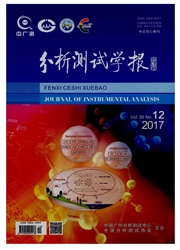

 中文摘要:
中文摘要:
采用滴涂法和电聚合法制备了碳纳米管/铁氰化铜复合修饰电极(MWCNTs—CuHCE/GCE),用交流阻抗法对其进行表征。并利用循环伏安法(CV)研究了萘酚异构体(α-N和/β-N)在该修饰电极上的电化学行为,考察了缓冲液、pH值、修饰剂用量、电聚合圈数及扫描速率对测定的影响。结果表明,在pH7.0的PBS缓冲液中,α—N和β-N的氧化峰得到了较好分离,分别于0.335V和0.505V处出现一不可逆氧化峰,且在40—220mV/s范围内,二者氧化峰电流与扫速(v)呈良好的线性关系,表明电极过程是受吸附控制的不可逆过程。计算了α—N和β-N在该修饰电极上的部分动力学参数。优化了差分脉冲伏安法(DPV)的实验参数,并对α-N和β-N进行了同时测定,发现二者的微分氧化峰电流值与其浓度在0.5—100μmol/L范围内呈良好的线性关系(rα-N=0.992;rβ-N=0.996)。采用该法对实际水样进行检测,α—N和β-N的加标回收率分别为94.2%-105.7%和90.2%~103.3%.
 英文摘要:
英文摘要:
A new carbon nanotubes and cupric hexacyanoferrate modified electrode (MWCNTs -CuH- CF/GCE) was prepared by drop coating and electropolymerization. The properties of electrode surface were characterized by Nyquist plots. The electrochemical behaviors of α-N and β-N on MWCNTs -CuHCF/GCE was investigated by cyclic voltammetry(CV). Influences of type of buffer solution, pH value, amount of MWCNTs, electropolymerization of CuHCF and scan rate were discussed. The results indicated that there were two obvious oxidation peaks of α-N and β-N appearing at 0. 335 V and 0. 505 V, respectively. The oxidation peaks of α-N and β-N were completely separated and the oxidation peak currents of both α-N and β-N were linear with scan rate (v) in the range of 40 - 220 mV/s, which showed that the electrode processes of α-N and β-N were controlled by adsorption. The electron number( n), proton number(m) , adsorption capacity(F) and effect area(A) of the modified electrode were studied. Under the optimal derviative technique was used to determine conditions, the differential pulse vohammetry (DPV) with naphthol isomers quantitatively. Good linear relationships between peak currents and concentrations of α-N andβ-N were observed in the range of 0. 5 - 100 μmol/L(rα-N= 0. 992;rβ-N = 0. 996). The proposed method was applied in the determination of α-N and/3-N in water samples with spiked recoveries of 94. 2% - 105.7% and 90. 2% - 103.3% , respectively.
 同期刊论文项目
同期刊论文项目
 同项目期刊论文
同项目期刊论文
 期刊信息
期刊信息
